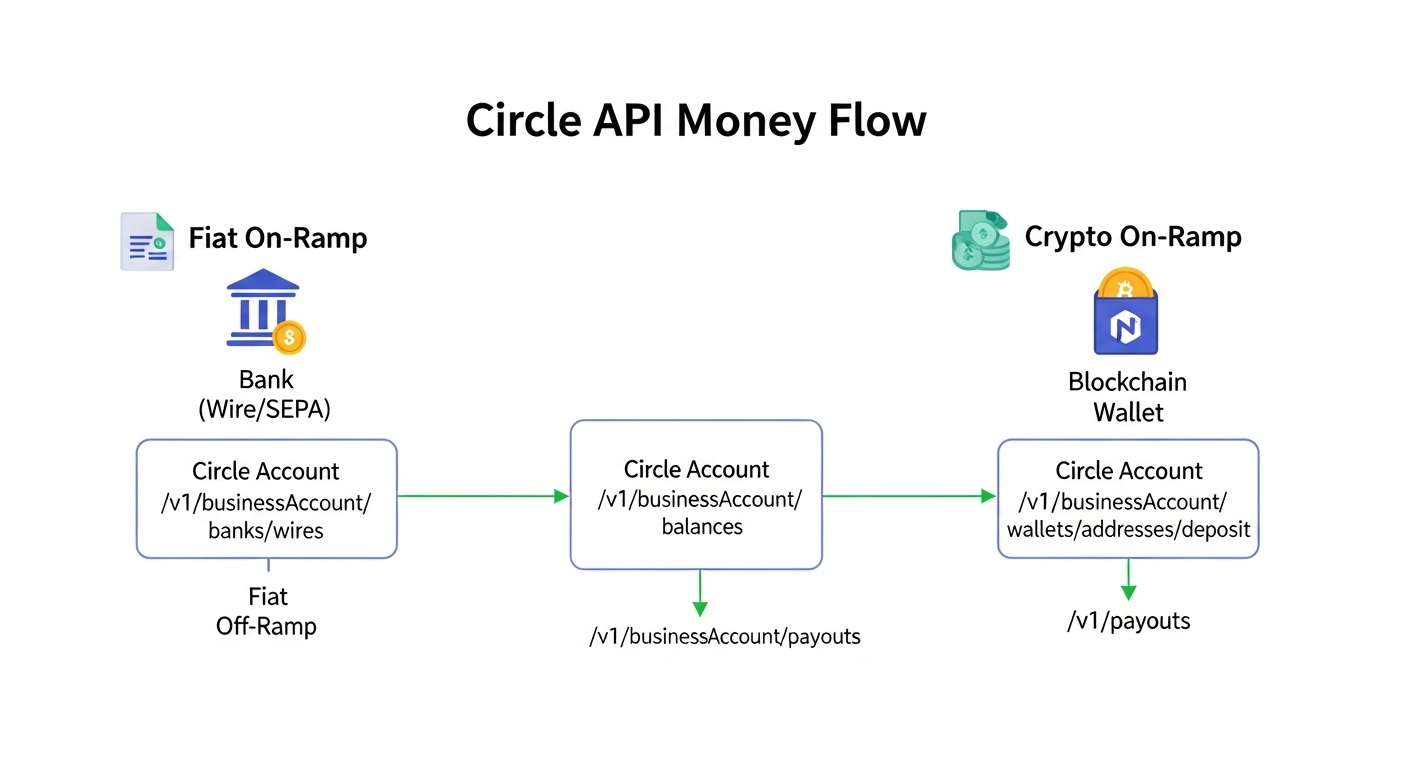1. Initial Setup & Authentication
This tutorial provides a complete, copy-paste cURL workflow for moving USDC and EURC with Circle's APIs.
First, set up your shell environment for the sandbox:
export CIRCLE_API_KEY="YOUR_API_KEY"
export CIRCLE_API_BASE="https://api-sandbox.circle.com"
alias ccurl='curl -H "Authorization: Bearer $CIRCLE_API_KEY" -H "Content-Type: application/json"'
Next, verify authentication and retrieve your masterWalletId:
ccurl "$CIRCLE_API_BASE/v1/configuration"
All examples use the sandbox. For production, update the CIRCLE_API_BASE URL.
2. Fiat On-Ramp: Wire to USDC/EURC
Link a US bank account.
export BANK_ID=$(ccurl -X POST "$CIRCLE_API_BASE/v1/businessAccount/banks/wires" -d '{
"idempotencyKey": "'$(uuidgen)'",
"accountNumber": "123456789",
"routingNumber": "021000021",
"billingDetails": {
"name": "John Smith",
"city": "Boston",
"country": "US",
"line1": "1 Main Street",
"district": "MA",
"postalCode": "02201"
}
}' | jq -r '.data.id')
echo "Bank ID: $BANK_ID"
Retrieve deposit instructions to get the trackingRef.
export TRACKING_REF=$(ccurl "$CIRCLE_API_BASE/v1/businessAccount/banks/wires/$BANK_ID/instructions" | jq -r '.data.trackingRef')
echo "Tracking Ref: $TRACKING_REF"
Simulate an incoming wire transfer using the sandbox-only mock API.
ccurl -X POST "$CIRCLE_API_BASE/v1/mocks/payments/wire" -d '{
"trackingRef": "'$TRACKING_REF'",
"amount": {
"amount": "1000.00",
"currency": "USD"
}
}'
Verify the mock deposit is complete.
ccurl "$CIRCLE_API_BASE/v1/businessAccount/deposits?type=WIRE"
3. Crypto On-Ramp: Deposit from an External Wallet
Generate a deposit address to receive USDC or EURC from an external blockchain wallet. Specify the currency ('USD' for USDC, 'EUR' for EURC) and the chain (e.g., 'BASE', 'ETH').
ccurl -X POST "$CIRCLE_API_BASE/v1/businessAccount/wallets/addresses/deposit" -d '{
"currency": "USD",
"chain": "ETH"
}'
Note: Funds must be sent to this address using the correct Circle-issued token contract for the specified chain. Refer to the official list of Supported Tokens.

5. Checking Balances
Check your balances for USDC and EURC.
ccurl "$CIRCLE_API_BASE/v1/businessAccount/balances"
The response separates funds into available (ready for use) and unsettled (pending settlement, e.g., from a wire deposit). currency: "USD" represents your USDC balance, while "EUR" represents EURC.
6. Crypto Payout: Sending USDC/EURC
First, add the recipient address to your address book.
export RECIPIENT_ID=$(ccurl -X POST "$CIRCLE_API_BASE/v1/addressBook/recipients" -d '{
"idempotencyKey": "'$(uuidgen)'",
"address": "0x...",
"chain": "ETH",
"description": "My Payout Address"
}' | jq -r '.data.id')
echo "Recipient ID: $RECIPIENT_ID"
Poll the recipient's status until it becomes active; new addresses may require a brief review period.
Once active, create the payout using the recipient ID.
ccurl -X POST "$CIRCLE_API_BASE/v1/payouts" -d '{
"idempotencyKey": "'$(uuidgen)'",
"source": {
"type": "wallet",
"id": "'$masterWalletId'"
},
"destination": {
"type": "address_book",
"id": "'$RECIPIENT_ID'"
},
"amount": {
"amount": "100.00",
"currency": "USD"
}
}'
Note: Payouts over $3,000 require additional Travel Rule information.
7. Fiat Payout: Withdrawing to a Bank
To off-ramp from USDC/EURC to a linked bank account, create a payout using the /v1/businessAccount/payouts endpoint. This is distinct from the endpoint used for crypto payouts.
Set the destination type to wire and use the $BANK_ID from the on-ramp step as the id.
export PAYOUT_ID=$(ccurl -X POST "$CIRCLE_API_BASE/v1/businessAccount/payouts" -d '{
"idempotencyKey": "'$(uuidgen)'",
"destination": {
"type": "wire",
"id": "'$BANK_ID'"
},
"amount": {
"amount": "500.00",
"currency": "USD"
}
}' | jq -r '.data.id')
echo "Payout ID: $PAYOUT_ID"
Check the payout status using its ID.
ccurl "$CIRCLE_API_BASE/v1/businessAccount/payouts/$PAYOUT_ID"
8. Critical Guardrails & Next Steps
- Asset Warning: Only send native Circle-issued USDC and EURC to your deposit addresses. Sending other assets will result in a permanent loss of funds.
- Chain Support: Always verify the list of supported chains for USDC versus EURC before initiating a transfer, as they differ.
- Testnet Funds: Obtain testnet USDC and EURC for sandbox development from the Circle Faucet.
To build on this foundation, explore Circle's Programmable Wallets for building web3 applications, or use the Cross-Chain Transfer Protocol (CCTP) for native, permissionless USDC transfers between chains.
